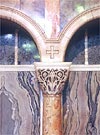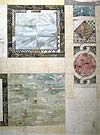Cathedral Marbles
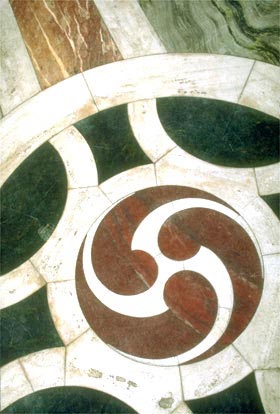
The distinctive design for the floor of St Patrick's Chapel.
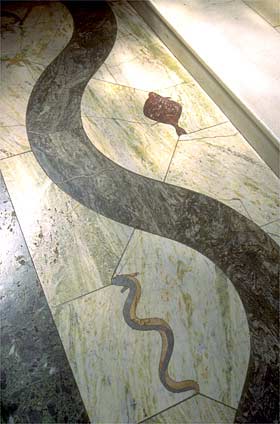
Flat fish, eels and other sea creatures
in the floor of St Andrew's Chapel.
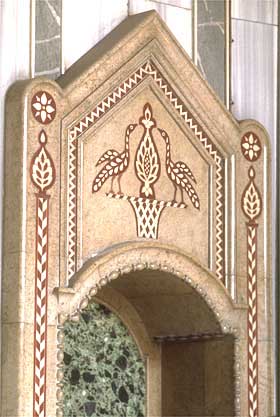
Piscina in St Paul's Chapel.
Over a hundred different varieties of marble decorate Westminster Cathedral (126 at the last count), almost certainly more than in any other building in England. They come from twenty-four countries on five continents and many of them were used in ancient Greece and Rome.
On entering the Cathedral by the main entrance you are likely to be standing on light blue-grey bardiglio fiorito (flowered blue) from the Carrara area of Tuscany. Immediately in front are two red columns, a reminder that the Cathedral is dedicated to the Precious Blood. They are of Swedish* red granite with bases of dark grey Norwegian Larvikite showing iridescent flecks of silvery mica, and with capitals of carved Carrara statuary marble. All the nave column capitals were meticulously designed by the architect, J F Bentley, in the Byzantine style.
Looking down the nave the dark green columns on either side are verde antico from Thessaly in Greece. They come from a series of ancient quarries which supplied the columns for Byzantine churches such as Santa Sophia and Sergius and Bacchus in Constantinople. Between the columns are great brick-built piers. The smaller are clad with Greek cipollino from the Island of Evia, used extensively in ancient Rome. The larger are faced with Cork red from near Midleton in Co Cork, Ireland, and Campan vert from the Commune of Campan, near Lourdes in the French Pyrenees.
Moving to the right down the south aisle you come to the Chapel of St Gregory and St Augustine. Most of the marbles here are Italian - a lovely panel of Carrara statuary on the floor above Cardinal Hume’s tomb, yellow and black Tuscan breccia below the windows and veined dark red rosso di Levanto from Liguria for the bench below. The altar frontal is also from Italy, exceptionally beautiful slabs of yellow Siena, but the great twin entrance columns are waxy Swiss cipollino from the Canton Valais, while the altar table is Norwegian pink from Fauske, with the rather attractive title of ‘Midnight Sun’ - you can see why.
On now to the Chapel of St Patrick where Irish marbles are much employed - wavy green Connemara for the altar frontal and floor, Cork red for the little columns below the windows, the centre of the altar frontal and also much of the floor, and Kilkenny black fossil marble for the altar top. But marbles from many other countries also appear. Below the altar is a design combining turquoise Amazonite from Colorado with dark blue Chilean lapis lazuli in a surround of green verdite from Pemberton in the Transvaal. Above the niches either side of the altar, French red Languedoc encloses diamonds of red and grey africano marble - certainly ancient since the old Roman quarry, near Izmir in Turkey, had flooded, become a lake and remained undiscovered until 1966.
Passing down the aisle between more panels of yellow and black Tuscan breccia we come to St Andrew’s Chapel with its ‘pavement like the sea’. Besides being the patron saint of Scotland, St Andrew was a fisherman so the floor uses marble to remind us of this. The central floor panels are swirling purple and white Arni fantastico from Tuscany. The surrounding dark green wave is Connemara and the light green and white marble, which contains twenty-nine sea creatures, is from the Iona marble quarry in Scotland. This closed in 1914 with the war but the workings and machinery can still be seen. The altar in St Andrew’s consists of three Scottish granites - The table of Alloa, the pillars of red Peterhead and the base of Aberdeen.
|
An English marble can be seen between St Andrew’s and St Paul’s Chapels. The skirting here is light grey Derbyshire fossil from Wirksworth and contains a myriad of sea creatures. The grey piscinas either side of the altar in St Paul’s are also from Wirksworth - Hopton Wood stone this time. But the main marbles in this Chapel are Turkish and Greek. Grey and white banded Proconnesian from the Turkish Island of Marmara lines the wall behind the altar, which is of translucent white Pentelic from Mount Pentelikon near Athens - used to build the Parthenon.
Dusky grey Hymettian, also from near Athens, lines the walls. The floor provides another attraction. It combines Greek green porphyry and verde antico with Egyptian purple porphyry in a nice example of Cosmatesque work. The nearby pulpit, and the delightful floor panel (designed by Aelred Bartlett) below the statue of Our Lady of Westminster, are also in the Cosmatesque style.
Before the Lady Chapel stand two imposing red columns from Languedoc in France. The lower walls in the Chapel display pink-flushed giallo antico from Kleber in Algeria and dark red rosso antico from the Mani in southern Greece. Next door, in the main sanctuary, the side columns behind the wooden stalls are also French, rouge jaspe from near Toulon, alternating with Norwegian pink. But the column capitals remain uncarved. The high altar, twelve tons of Cornish granite, stands beneath its canopy of white Carrara inlaid with coloured marbles and resting on eight columns of yellow Verona. Looking back down the nave, our latest (1995) marbles can be seen fronting the piers at gallery level - dark red rosso Laguna from Turkey and light blue Azul Macaubas from Brazil.
Another marble from Kleber, the deeper pink, rose de Numidie, lines the walls in the Blessed Sacrament Chapel, together with yellow Siena. Further on, the Vaughan Chantry encloses the effigy and empty tomb of the Cathedral’s founder (Cardinal Vaughan) in carved white Pentelic. Two striking black and white columns, known as grand antique des Pyrenees or bianco e nero, stand outside. This French marble from Ariege was also used in Roman and Byzantine buildings. Next, to St Joseph’s Chapel, where slabs of cipollino, cut from the same block, have been opened out to create attractive patterns. In front of them are little colonettes of onyx with a central column of Tuscan fior di pesco, peach-blossom marble.
Next door is the Chapel of St George and the English Martyrs, so many of the marbles are red - Greek rosso antico inlaid with mother-of-pearl roses on the wall above the altar, rouge sanguine from Kleber on the altar frontal, with dark red French rouge griotte (called partridge-eye because of its pearly white spots or eyes) on the floor, with a red English rose of rosso antico in the centre. The final chapel is that of the Holy Souls, with its themes of death and mourning. Here the colours are subdued - an entrance column of silver-grey Norwegian Larvikite with floor and walls of grey bardiglio fiorito and dark green verde di mare (green of the sea) from Genoa. And so we come to the bronze statue of St Peter, the rock on which our Church is founded, and are back to where we started - which is always a good place to stop.
* Though listed at the time as Norwegian, Norway’s Geological Survey in Trondheim confirm that Norway does not (and did not) produce red granite.
Patrick Rogers
First published in Oremus, the magazine of Westminster Cathedral September 2000


